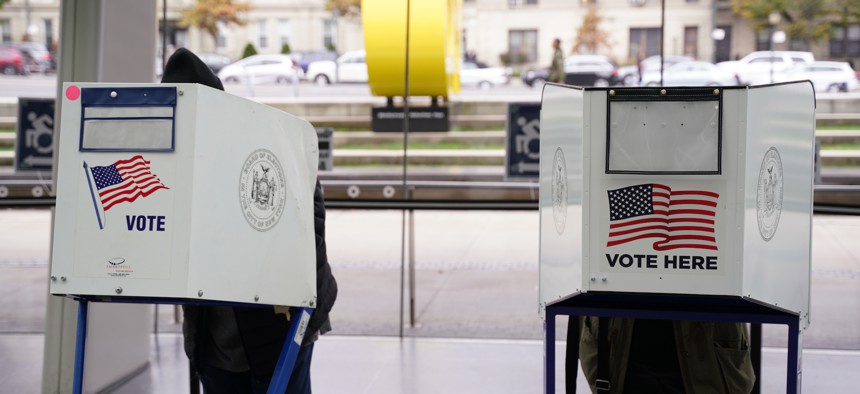Opinion
Opinion: Get ready for the return of the ‘unexpected voter’
These are the ones who actually show up at the ballot box, and who aren’t part of targeted campaign promotions

With primary day coming up tomorrow, New York City should expect the return of the “unexpected voter,” write Bradley Honan and Elisabeth Zeche, partners at Democratic polling and data analytics firm Honan Strategy Group. Lokman Vural Elibol/Anadolu Agency via Getty Images
Voter turnout for Tuesday’s primary election across New York City is expected to be modest at best. There are no city-wide races, only several boroughs have borough-wide races, and many City Council races are not being energetically contested.
But regardless of how many voters ultimately turn out and cast a ballot on Tuesday (or have done so already by voting early or voting via absentee ballot), there is an important voter turnout trend at work today – the rising importance of the unexpected voter.
The political data that we are seeing and analyzing across the country, but certainly on display in New York, too, is that voter turnout has reached an important inflection point. Simply put, a relatively large number of voters who we would expect to turn out for a primary election due to their recent active primary voting participation, ultimately stay at home and never cast a ballot – call these “expected voters” who don’t show up. At the same time, voters with relatively poor recent primary voting history are turning out and voting in primary elections – call these “unexpected voters” – and importantly their electoral impact is often decisive in many close primary races.
First, a little background. The traditional ways that political campaigns select the most likely pool of voters they will go after to try and win is at best a crude (and inaccurate) instrument. Here is how it works: “Double primes” – those who have voted in at least two recent primary elections or two recent municipal primary elections – and/or “triple primes” – those who have voted in at least three recent primary elections – are selected from the voter file as the group of voters most likely to turnout. A typical campaign will then focus the entirety of their paid targeted communication resources on this pool of voters – and nobody else.
However, the recent volatility of election behavior – pre and post-Donald Trump – has created a new normal for voter turnout – where the past predictors of primary day or election day turnout are no longer as accurate as they once were.
And this matters a whole lot. Indeed, many important elections are decided by a small vote margin. We have written about Alexandria Ocasio-Cortez’s slim 4,018 vote margin victory over Joe Crowley which arguably changed the direction of the national Democratic Party – sending it in a leftward direction.
Let’s examine two recent elections to dive into this reality in more detail. Consider some of the following data from Engage Voters: 142,934 New York City Democratic Primary voters who had voted in at least two of four recent Democratic primary elections, did not vote in the hotly contested June 2021 Democratic primary for mayor – a number much larger than Eric Adams’ margin of victory over Kathryn Garcia – just 8,426 votes.
At the same time, 229,851 New York City Democratic voters who had voted in none of the last 4 elections actually came out and voted in the June 2021 Democratic Primary for Mayor. Yes – that is no typo. More than 200,000 Democratic voters with zero recent primary voting history cast a ballot. Traditional voter targeting means that not a single one of these voters received any targeted campaign communications like direct mail, phone banking, texting, or canvassing.
But isn’t this an unusual New York City example? No, not at all.
Let’s examine last June’s Democratic primary for Governor: 857,452 expected Democratic primary voters – those who had voted in at least 2 recent Democratic primaries didn’t vote in the June 2022 Gubernatorial Primary. Who made up for this? According to Engage Voters,107,381 voters with no primary voting history over the last 4 major primaries turned out, as did a staggering 791,563 voters who had voted in only 1 recent primary. To put things into perspective, the unexpected vote was almost twice as large as Hochul’s margin of victory over 2nd place Jumaane Williams – 410,657 votes.
We think this trend of unexpected voters showing up is due to several reasons. First, local issues - often ones related to development or public projects – are generating political and civic engagement, which didn’t exist in prior races and so these voters stayed home in past elections. Social media is bringing these issues to people’s doorsteps, even if conventional targeted campaign tactics are not reaching these voters.
Second, on-the-ground organizing which is often haphazardly done, creates a reason to vote – a human and emotional connection that may not have existed in the past and from what we see, the power of peer-to-peer organizing and communications is only growing in importance.
What does this mean?
In our eyes, political campaigns going forward are going to need to:
- Recognize traditional voter targeting techniques are not nearly as precise as they need to be.
- Spend more time studying the voter file and identifying Hansel and Gretel-like breadcrumbs that may suggest which expected voters may be dropping-off, and which unexpected voting are surging in their election participation.
- Create turnout models that are more updated and take into account much more contemporary political insights and information about the mindset and behavior of voters.
- Better leverage the computing power of AI to develop new ways of predicting turnout.
Bradley Honan and Elisabeth Zeche are partners at the Democratic polling and data analytics firm Honan Strategy Group. Honan is also co-president of the New York Metro Chapter of the American Association of Political Consultants.
NEXT STORY: Opinion: Albany, stop making excuses for keeping basement homes unsafe

